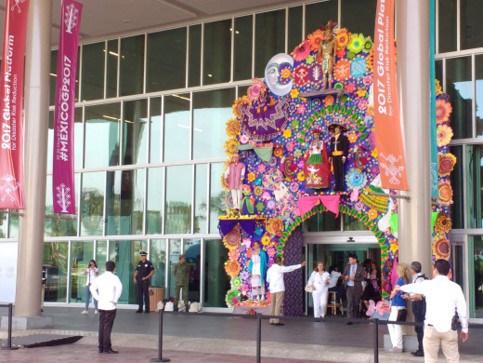Disaster risk reduction and evidence: A worrying trend

Photo: Jeroen Jansen
In the coming weeks, many will look back on the recent 2017 Global Platform for Disaster Risk Reduction (2017GP) in Cancun, Mexico, and reflect on its potential contribution to the implementation of the Sendai Framework for Disaster Risk Reduction. Some experts on issues related to disaster risk reduction (DRR) will argue that great progress was made, while others will provide a critical voice arguing the opposite. Both sides will most likely refer to the many examples of scientific and technological advances presented, and new policies and strategies shared during the 2017GP. However, those hearing and reading about these examples need to be very wary. Sadly, many of the examples provided during the 2017GP are of questionable value. They often mentioned ‘best’ or ‘good’ practices, but provided little or no methodology to substantiate their conclusions, recommendations or activities. We came away asking ourselves: where was the evidence?
In the DRR sector, the limited concept of ‘best’ or ‘good’ practice seems to be or is becoming the dominating, and almost religiously adhered to dogma, at the expense of a more robust evidence-based approach. During one of the sessions at the 2017 GP, a panel of five scientists attempted to define ‘best’ or ‘good’ practice and clarify what methodology was applied to differentiate between good and bad practice. Their take home message seemed to be simply that they trust the person who identifies it as best practice. In other words, these ‘scientists’ feel that the personal opinion of one person constitutes sufficient evidence to substantiate their work. Evidence based medicine has shown us over the last few decades that this “expert knows best” approach to decision making is inadequate and dangerous and if this kind of references to ‘best’ or ‘good’ practice is the norm within the DRR sector for substantiating decisions and activities, the sector is in the dark ages of science where oracles are consulted for advice and wisdom. This fanatic adherence to the often not useful dogma of ‘best’ or ‘good’ practice needs to be eradicated, in favour of a more evidence-based approach with robust, defensible and reliable methodologies. Expert opinion and other sources of information have a role, but only if deployed in a transparent and structured manner, while applying a clear and appropriate methodology and taking into consideration its relationship to other evidence.
Possibly the most disconcerting aspect is the adherence to this dogma of ‘best’ and ‘good’ practice among those that refer to themselves as ‘scientists’ or ‘academics’, those who generate the evidence and who should be the guardians of an evidence-based approach. They seem to increasingly deploy a narrative that reveals a growing similarity with that used by actors who understand – or care – less about the importance of an evidence-based approach to DRR. There is a need to recognise that the often technical and academic language deployed when elaborating on scientific evidence is not the most inspiring for those who hold the power to ensure implementation. Nevertheless, the need for more engaging language should not become the justification to abandon an evidence-based approach to substantiate the policies, strategies, standards and indicators that guide the implementation of the Sendai Framework for Disaster Risk Reduction.
The implementation of the Sendai Framework is fast gaining momentum, triggering a growing demand for robust evidence to inform policies, standards and indicators. In response, the UNISDR Science and Technology Partnership for the Implementation of the Sendai Framework was launched during the 2016 UNISDR Science and Technology Conference in Geneva. The partnership aims to advance the role of science and technology in the implementation of the Sendai Framework and its Roadmap clearly assigns a role to its partners in the generation, dissemination and promotion of scientific evidence. This implies that the Science & Technology partners of the Sendai Framework have a responsibility to ensure that DRR activities and decisions are evidence-based when and where appropriate, and that evidence is generated by applying robust methodologies in a transparent way. Successful adaptation of this evidence will also depend on others actors, especially those who are influential in the implementation of DRR.
Evidence Aid is a Science and Technology partner and one of its core activities is the promotion of an evidence-based approach to DRR and humanitarian activities and decisions more generally. It works with those that guide or fund these sectors to make their decisions and activities more evidence based. During the 2017GP, Evidence Aid questioned some of the evidence presented and advocated for a more evidence-based approach, but one small organisation cannot alone turn the tide on the rise of the questionable dogma of ‘best’ or ‘good’ practice. Together, the Science & Technology partners of the Sendai Framework need to champion an evidence based approach to safeguard the effectiveness and efficiency of DRR activities and ensure value for money. Only by joining forces will the Science and Technology Partners be able to direct the entire DRR community towards an evidence-based approach that will lead to successful implementation of the Sendai Framework.
This post was orignally published on Evidence Aid blog.
Jeroen Jansen was appointed as the first Director of Evidence Aid in September 2015. He is the former Head of the Programmes Unit at Médecins Sans Frontières (MSF) in London and a current board member of MSF Spain. Jeroen has championed an evidence-based approach to humanitarian aid throughout his career in the humanitarian sector. His many field assignments for MSF in countries such as Afghanistan, Liberia, Nigeria and South Sudan gave him first-hand experience of the need for evidence in the field.